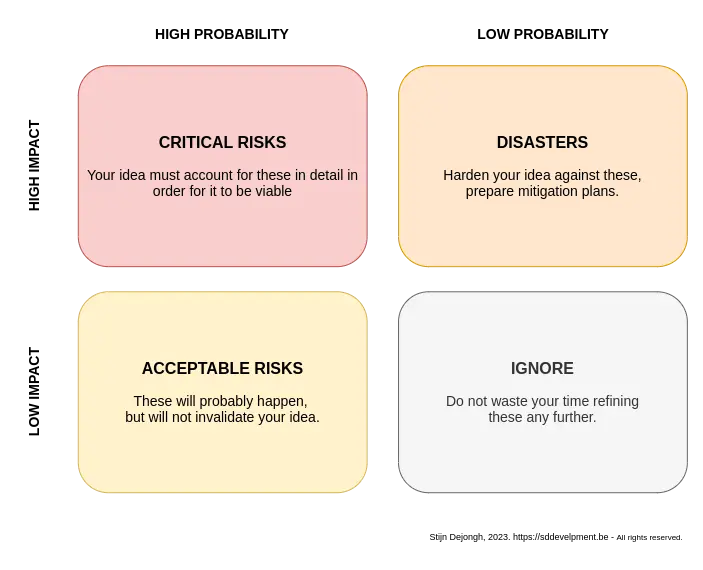Plan a self-sabotage

Problem statement
You have an idea and want to strengthen it against negative forces.
Intent
- Discover critical risks to your ideas.
- Reflect on ways to cope with setbacks.
- Harden your idea by limiting failure conditions.
Solution
- Challenge your own ideas
- Begin by actively sabotaging your own ideas and plans.
- Delve deep into your suggested approach and ask, “How can I ensure this fails?”.
- Encourage creativity and explore beyond common expected issues.
- The effectiveness of this technique relies on your willingness to undermine yourself.
- Create a Comprehensive List
- Compile a list of all the ways you can guarantee failure.
- Organize these potential failure scenarios from “most impactful” to “least impactful.”
- Prioritize addressing the five most impactful scenarios as a starting point.
- Assess Likelihood (Optional):
- For a more thorough evaluation, assign a likelihood rating to each “sabotage” scenario, ranging from high probability to low probability.
- This assessment will allow you to create a 2-by-2 matrix, helping you visualize and prioritize potential issues.
- Mitigate Impact of Failures:
- Consider and develop strategies to mitigate the three most likely high-impact failure scenarios.
- Consider and develop strategies to mitigate the three least likely high-impact failure scenarios.1
- Track potential risks:
- During execution of your plan, actively track and reassess the risks to your idea. Be prepared to act!
- Concentrate your attention and efforts on the failure modes that have the highest impact, as identified in the matrix.
By following this systematic approach, you can proactively strengthen your ideas against negative forces, ensuring they are more resilient and better prepared for potential challenges.
Contextual forces
Enablers
The pattern works well when there is a need for thorough risk assessment and when the individual or team is open to critically evaluating their own ideas. It is effective in environments where creativity and innovation are valued, but there is also a strong emphasis on mitigating potential risks. The pattern is particularly useful when clear thinking and objective analysis are required to ensure that an idea or plan can withstand challenges.
The following factors support effective application of the practice:
- The individual or team can think creatively about potential failure points.
- There is a willingness to critically assess and attack one’s own ideas.
- Access to resources or prior knowledge about common pitfalls is available.
- There is access to knowledgeable individuals for feedback and insights.
Deterrents
The pattern may not work well in environments where there is a lack of resources, time, or willingness to engage in critical self-assessment. It can also be less effective if there is an overemphasis on identifying risks, leading to paralysis by analysis or a negative mindset that stifles progress. Additionally, it may not be suitable in fast-paced environments where rapid iteration and flexibility are more valuable than exhaustive risk mitigation.
The following factors prevent effective application of the practice:
- You do not have access to others / prior knowledge.
- You have difficulties finding/accepting issues with your own ideas or creations.
Rationale
Creativity and Blind Spots
- Creative thinking can make it challenging to identify flaws in your plans.
- Common cognitive biases come into play:
- Selection bias: Only taking into account part of the information available to you, as it fits what you want to believe.
- Effort justification: Overvaluing something, because you have put effort into it.
- Illusion of validity: Overestimating your ability to interpret and accurately predict the outcome of when analysing a set of data.
- Illusion of explanatory depth: Believing you understand something much more thoroughly than you actually do.
Perspective Shifting
- Emotionally investing in your ideas can hinder clear reasoning.
- Mentally shifting from a constructive to a destructive mode helps distance yourself from biases.
Application
Consequences
- Over-emphasis on Risks: Focusing too much on potential failures can lead to excessive caution and hinder progress.
- Time and Effort: Conducting a thorough self-sabotage analysis requires significant time and effort, potentially detracting from other productive activities.
- Negative Mindset: Continually thinking about how things can fail might foster a negative mindset, which can be demotivating and counterproductive.
Mitigation strategies
- Balance Risk Assessment: Maintain a balanced approach by also considering potential positive outcomes and opportunities.
- Allocate Time Wisely: Schedule dedicated time for self-sabotage analysis to ensure it does not interfere with other important tasks. Know when to stop and move forward. Not every potential risk warrants extensive mitigation.
- Foster a Positive Environment: Encourage a positive mindset by celebrating small successes and learning from identified risks rather than focusing solely on failures.
Criticism & Clarifications
- Self-sabotage exercises can drift into catastrophic thinking; pair them with “what would make this succeed?” to keep morale intact.
- Some stakeholders experience analysis fatigue—timebox the activity and socialise outcomes so it feels purposeful, not indulgent.
- When risks implicate sensitive people or vendors, anonymise or park the detail so the exercise remains psychologically safe.
The idea being that the unlikely, high-impact failure modes are usually what catches people by surprise, and tend to ruin a plan as no one bothered to think about mitigation strategies. An example from the technology world: “What if a hurricane destroys our data centre?”. ↩︎
